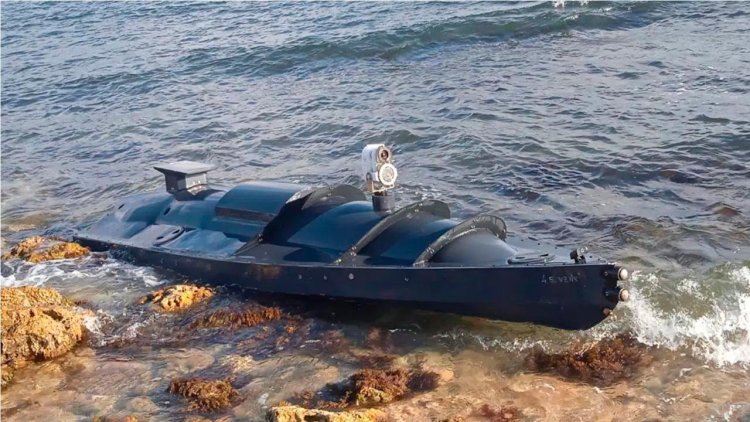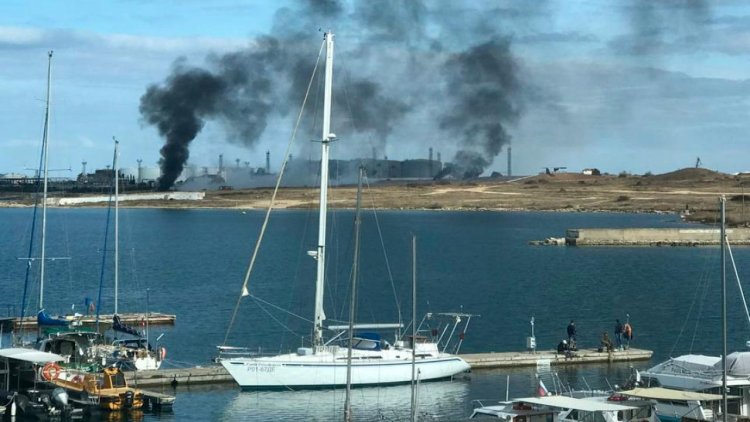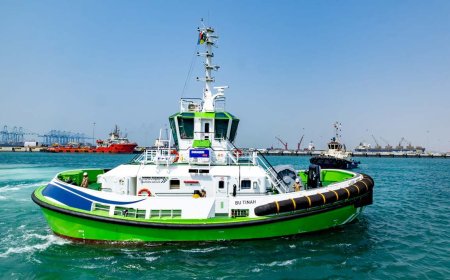Ex-Navy captain: Ukraine’s drone attack in Sevastopol ‘has no equivalent in the history of naval warcraft’
The low cost, maneuverability, and effectiveness of the drones have led to the attack on Sevastopol being described as a revolutionary moment in the development of modern naval warfare.

In the early hours of Oct. 29, the famous naval harbor of Sevastopol in occupied Crimea, home to Russia’s Black Sea Fleet, was rocked by a series of mysterious explosions.
Details were scarce at first, but with the coming of dawn, remarkable footage was released of sleek, black maritime drones maneuvering around the bay on the way to their targets: Russian warships. Seven maritime and nine aerial drones were reported to have been used in the coordinated attack, which damaged the flagship of the Russian Black Sea Fleet Admiral Makarov as well as other vessels.
Russia blamed the attack on Ukraine. Ukraine hasn’t recognized that it was behind the attack. Soon after, President Volodymyr Zelensky announced the start of a fundraising campaign to secure “a fleet of marine drones.”
With the nearest Ukrainian-controlled coastline almost 300 kilometers from Sevastopol, the ability of these drone boats to reach their targets in the heart of Russian naval power in the Black Sea shocked observers. Comparisons have been made to Japanese suicide boats used in World War II, or even further back, to unmanned fire ships used in the Age of Sail.
The low cost, maneuverability, and effectiveness of the drones have led to the attack on Sevastopol being described as a revolutionary moment in the development of modern naval warfare.

Photo: Benjamin Pittet/Twitter
The Kyiv Independent spoke to military analyst, former Ukrainian Navy captain, and Black Sea security expert Pavlo Lakiychuk about what the attack on Sevastopol means for the Black Sea theater of Russia’s war, and its implications for naval warfare worldwide.
The Kyiv Independent: What was your immediate reaction to the drone attack on the Black Sea Fleet in Sevastopol? Were you surprised, or did you predict something like what happened?
Pavlo Lakiychuk: I can't say I was surprised, no. In recent months we had seen more and more flying drone attacks against military targets in Crimea, starting from the attacks on airfields in Novofedorivka, Belbek, Dzhankoi and Hvardiiske, to the attacks on the Black Sea Fleet headquarters in Sevastopol. Ukraine has managed to get past the air defense of these bases on a consistent basis now. Just two weeks before this attack, the Russians found one of these drone boats in the area of Kozacha Bukhta. The photos of it match the footage from the attack in Sevastopol. I had no doubts that such an attack could happen, but in what exact fashion it would take place, I could not know; it was a well-kept secret.
The way they... I can't say who exactly... managed to pull it off was really impressive. I can't see any equivalent in the history of naval warcraft to an application of drones, both reconnaissance and attack, maritime and aerial, together like this. It's a new way of waging war on the sea. Nobody has done anything like this before.
The Kyiv Independent: A uniquely Ukrainian innovation?
Pavlo Lakiychuk: Yes – you could compare it in effect with a combined attack by traditional air and sea forces, but the difference here is that it was very difficult to detect. Like a scene from the game “Silent Hunter,” Ukraine directed its weapons to the target at a great distance away from the operation, and no Ukrainian soldier was harmed.
The Kyiv Independent: What can you tell us about these drone boats? What makes them so effective?
Pavlo Lakiychuk: At their size, objects like this are very difficult to detect. In the sea, not only are they very difficult to spot with the naked eye, but more importantly, they do very well to avoid detection by radar systems. They can't be seen by radars designed to detect missiles or torpedoes, and their small size means that their signal is broken up by the waves around them on the surface.
There are other reasons these drone boats were able to travel such great distances undetected; they were only detected when they began their final attack. The systems used to detect an object close to the surface like this are designed to listen for the acoustic signature of a torpedo engine, but these drones used pump jets.
Moreover, very specific tactical choices were made: to distract the enemy from sea targets and cause overall panic, the first strike came from the air. Only then, with the enemy scrambling to respond, came the attack from the sea.
Author: Francis Farrell

























































































































































